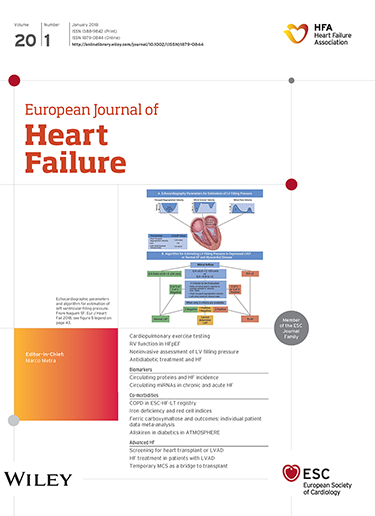411 807 名成年人长期暴露于细颗粒物成分、遗传易感性和心力衰竭事件。
IF 16.9
1区 医学
Q1 CARDIAC & CARDIOVASCULAR SYSTEMS
引用次数: 0
摘要
目的长期暴露于细颗粒物(PM2.5)与心力衰竭(HF)的发生有关,但其成分对心力衰竭的影响仍然未知。我们的目的是调查 PM2.5 成分与心力衰竭发病率的关系,并进一步评估遗传易感性的调节作用。方法和结果PM2.5 及其成分(包括碳元素 (EC)、有机物 (OM)、铵 (NH4+)、硝酸盐 (NO3 -) 和硫酸盐 (SO4 2-))是使用欧洲监测和评估计划模型(EMEP4UK)估算的,该模型应用于英国,由气象和研究预测模型气象学驱动。我们计算了多基因风险评分 (PRS),以表示对高频的遗传易感性。我们采用 Cox 模型来评估 PM2.5 成分与高频事件的相关性。我们使用基于量子的 g 计算模型来确定 PM2.5 成分的主要贡献者。在英国生物库的 411 807 人中,有 7554 人在中位随访 12.05 年期间患上了心房颤动。PM2.5、EC、OM、NH4 +、NO3 - 和 SO4 2- 每增加一个四分位数间范围,患高血压的调整危险比分别为 1.50(1.46-1.54)、1.31(1.27-1.34)、1.12(1.09-1.15)、1.42(1.41-1.44)、1.26(1.23-1.29)和 1.25(1.24-1.26)。EC(43%)起着最重要的作用,其次是 NH4 + 和 SO4 2-。此外,在同时暴露于PM2.5、NH4 +、NO3 -、SO4 2- 和PRS的人群中,9%-16%的心房颤动事件是由协同相加作用引起的。PM2.5成分和PRS对高频风险具有叠加效应。本文章由计算机程序翻译,如有差异,请以英文原文为准。
Long-term exposure to fine particulate matter constituents, genetic susceptibility, and incident heart failure among 411 807 adults.
AIMS
Long-term fine particulate matter (PM2.5) exposure has been linked to incident heart failure (HF), but the impacts of its constituents remain unknown. We aimed to investigate the associations of PM2.5 constituents with incident HF, and further evaluate the modification effects of genetic susceptibility.
METHODS AND RESULTS
PM2.5 and its constituents, including elemental carbon (EC), organic matter (OM), ammonium (NH4 +), nitrate (NO3 -), and sulfate (SO4 2-), were estimated using the European Monitoring and Evaluation Programme model applied to the UK (EMEP4UK) driven by Weather and Research Forecast model meteorology. A polygenic risk score (PRS) was calculated to represent genetic susceptibility to HF. We employed Cox models to evaluate the associations of PM2.5 constituents with incident HF. Quantile-based g-computation model was used to identify the main contributor of PM2.5 constituents. Among 411 807 individuals in the UK Biobank, 7554 participants developed HF during a median follow-up of 12.05 years. The adjusted hazard ratios of HF for each interquartile range increase in PM2.5, EC, OM, NH4 +, NO3 -, and SO4 2- were 1.50 (1.46-1.54), 1.31 (1.27-1.34), 1.12 (1.09-1.15), 1.42 (1.41-1.44), 1.26 (1.23-1.29), and 1.25 (1.24-1.26), respectively. EC (43%) played the most important role, followed by NH4 + and SO4 2-. Moreover, synergistic additive interactions accounted for 9-16% of the HF events in individuals exposed to both PM2.5, NH4 +, NO3 -, and SO4 2- and PRS.
CONCLUSION
Long-term exposure to PM2.5 constituents may elevate HF risk, and EC was the major contributor. Additive effects of PM2.5 constituents and PRS on HF risk were revealed.
求助全文
通过发布文献求助,成功后即可免费获取论文全文。
去求助
来源期刊

European Journal of Heart Failure
医学-心血管系统
CiteScore
27.30
自引率
11.50%
发文量
365
审稿时长
1 months
期刊介绍:
European Journal of Heart Failure is an international journal dedicated to advancing knowledge in the field of heart failure management. The journal publishes reviews and editorials aimed at improving understanding, prevention, investigation, and treatment of heart failure. It covers various disciplines such as molecular and cellular biology, pathology, physiology, electrophysiology, pharmacology, clinical sciences, social sciences, and population sciences. The journal welcomes submissions of manuscripts on basic, clinical, and population sciences, as well as original contributions on nursing, care of the elderly, primary care, health economics, and other related specialist fields. It is published monthly and has a readership that includes cardiologists, emergency room physicians, intensivists, internists, general physicians, cardiac nurses, diabetologists, epidemiologists, basic scientists focusing on cardiovascular research, and those working in rehabilitation. The journal is abstracted and indexed in various databases such as Academic Search, Embase, MEDLINE/PubMed, and Science Citation Index.
 求助内容:
求助内容: 应助结果提醒方式:
应助结果提醒方式:


